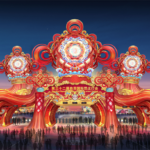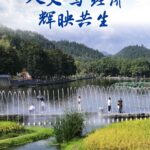Deepening the “curriculum + activities + practice” educational model, and creating a school aesthetic education ecosystem with the “Hongyan brand, Bayu characteristics, and digital empowerment,” the Municipal Education Commission recently issued the “Notice on the Comprehensive Implementation of School Aesthetic Education Infiltration Actions” (hereinafter referred to as the “Notice”), promoting high-quality development of school aesthetic education through eight major measures.
The “Notice” specifies that by 2027, a selection of Bayu-characteristic aesthetic education resources will be identified, a batch of high-quality discipline-based aesthetic education courses will be developed, a group of outstanding aesthetic education teachers will be cultivated, a series of exemplary aesthetic education research achievements will be established, and a number of pilot aesthetic education districts and schools will be recommended. This will form a high-quality development framework for school aesthetic education characterized by “distinctive courses, guaranteed faculty, innovative evaluations, and coordinated resources,” promoting balanced and inclusive urban-rural aesthetic education. On this basis, within the next 3 to 5 years, efforts will be made to advance a new aesthetic education framework that integrates moral, intellectual, physical, artistic, and labor education, spans early childhood to higher education, complements urban and rural inter-school resources, and fosters collaboration among families, schools, and society. The goal is to establish a comprehensive, diverse, and high-quality modern school aesthetic education system with Chongqing characteristics and Bayu heritage.
The “Notice” clarifies that the city will advance related work through eight aspects: deepening aesthetic education teaching reforms, enhancing teachers’ aesthetic literacy, popularizing artistic practice activities, fostering a campus aesthetic education culture, optimizing the aesthetic education evaluation system, improving rural aesthetic education quality, building a smart aesthetic education ecosystem, and establishing a collaborative social aesthetic education matrix.
Hongyan brand
The *Hongyan* brand is a historic Chinese automotive manufacturer, originally established in 1965 as part of the Sichuan Automobile Group. It is best known for producing heavy-duty trucks and military vehicles, playing a significant role in China’s industrial development. The brand symbolizes resilience and innovation, reflecting China’s growth in the automotive sector.
Bayu characteristics
“Bayu” (巴渝) refers to the ancient cultural and regional characteristics of the Ba and Yu areas, primarily corresponding to modern-day Chongqing and parts of Sichuan in China. Historically, it represents the distinct traditions, dialect, and customs of the ancient Ba people, known for their warrior culture, folk songs, and stilted architecture. Today, Bayu culture is celebrated through local opera, spicy Sichuan cuisine, and historical sites like the Dazu Rock Carvings.
digital empowerment
“Digital empowerment” refers to the process of enabling individuals and communities through access to digital tools, skills, and technologies, fostering inclusion, education, and opportunities. Historically, it emerged with the rise of the internet and digital literacy movements, aiming to bridge the digital divide and empower marginalized groups. Today, it plays a key role in global development, promoting equity, innovation, and participation in the digital economy.
Chongqing characteristics
Chongqing, a major city in southwestern China, is known for its mountainous terrain, hot pot cuisine, and rich history as a wartime capital during World War II. Its unique urban landscape, shaped by the Yangtze and Jialing rivers, features dramatic skyscrapers and traditional stilt houses (Diaojiaolou). The city also preserves cultural heritage like the ancient Ciqikou town and serves as a gateway to the Three Gorges.
Bayu heritage
Bayu Heritage is a cultural site in Malaysia, located in the state of Sarawak, known for its historical significance as an ancient trading hub and settlement for the indigenous Bidayuh people. The area features traditional longhouses, lush rainforests, and remnants of colonial-era influences, reflecting its rich multicultural past. Today, it serves as a destination for heritage tourism, offering insights into Borneo’s indigenous traditions and history.




